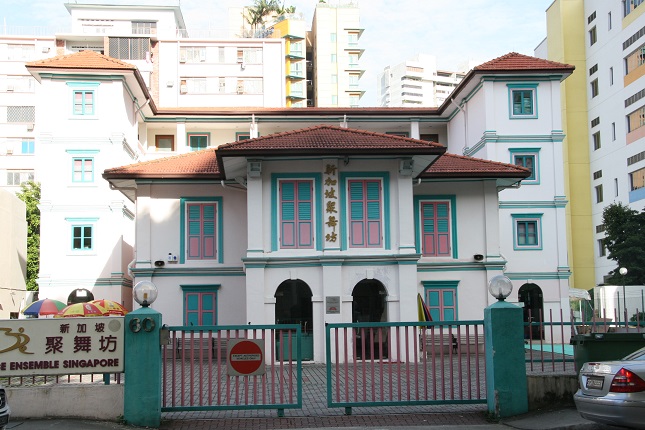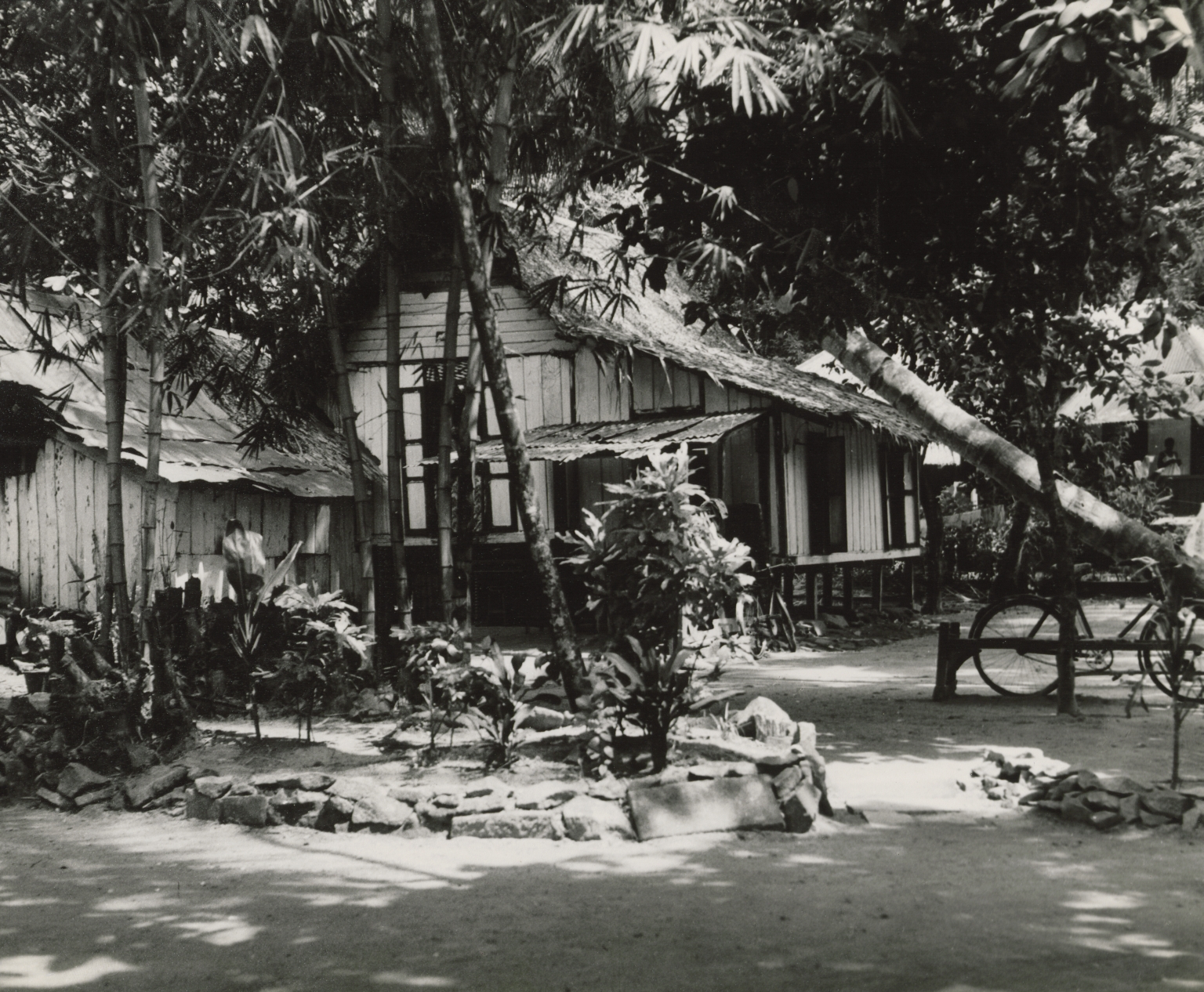What makes Singapore, Singapore? And what makes Singapore home? @ Home, Truly, follows Nadine, and her Gong Gong (Mandarin for “grandfather”) as they relive the highs, lows, and moments in between of Singapore’s journey from its beginnings as a nation to today.
Each chapter in this digital experience is illustrated by a different artist, in their own inimitable style. Check back every month for updates as our story unfolds!
This experience is presented in collaboration with The Straits Times. This is the third chapter of the story, and it explores the experiences of growing up in Singapore by different generations. Read on, or click here for the first chapter (and then come back to this one later)!
The Need for Needles
Hi! Welcome to Gong Gong’s dining room, which has served as nine-year-old Nadine’s café for the last two days. She’s at her Gong Gong’s home during the May holidays as her parents have to be at work for long hours.
Right now, Gong Gong and Nadine are in the middle of a chat about one of their favourite people – Nadine’s mum (or, Gong Gong’s daughter). Nadine finds it hard to believe that her mum, whom she’s always known to be calm, fearless, sometimes funny but mostly strict, was once a child!
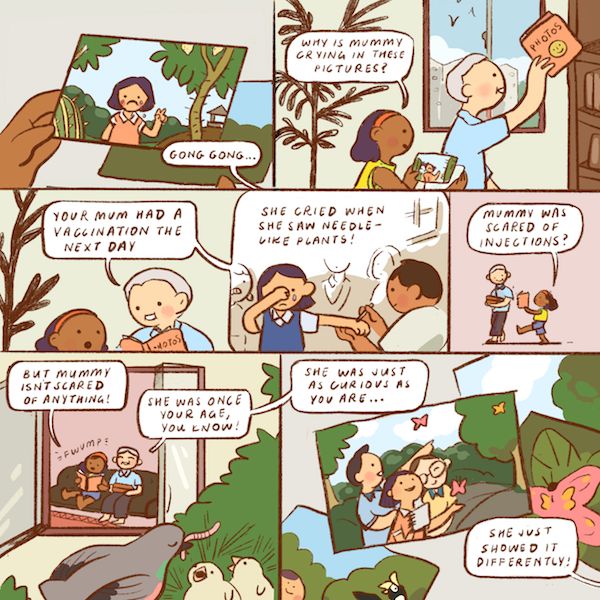
Psst! This chapter’s illustrations are by Joy Ho, an illustrator, cartoonist, and designer, whose works often take the form of ink or digital pieces – like scratchy dog comics or colourful, embodied smiley faces.
Vaccinations to give children immunity against common diseases have been administered in Singapore since as early as 1869 (when smallpox vaccination was made compulsory).

The BCG is the vaccine against tuberculosis, which was the top killer disease in Singapore in the post-war years before it subsided in the 1960s. Tuberculosis (also known as phthisis – try pronouncing that – or the white plague) is an air-borne bacterial infectious disease. From the mid-1950s onwards, BCG immunisation was administered at birth.
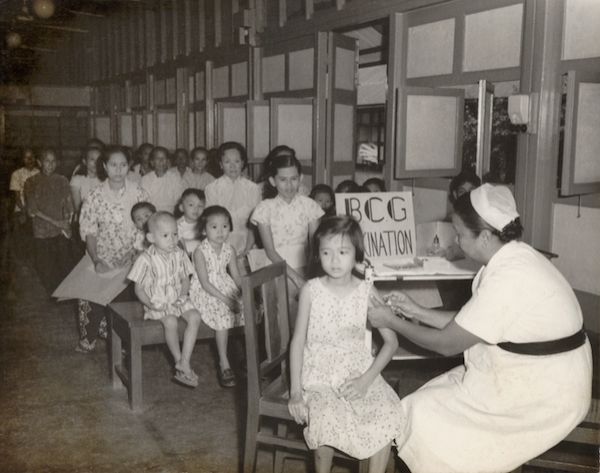
Many Singaporeans would also remember taking the BCG vaccination in school when they were 12 years old. However, the vaccine is most effective at preventing infants and young children from contracting severe forms of childhood tuberculosis, rather than adults. As such, BCG revaccination by the School Health Service was discontinued on 1 July 2001.
The Belles of CHIJMES
Now Nadine is really curious! “What was Mum like at my age? What was her childhood like?”
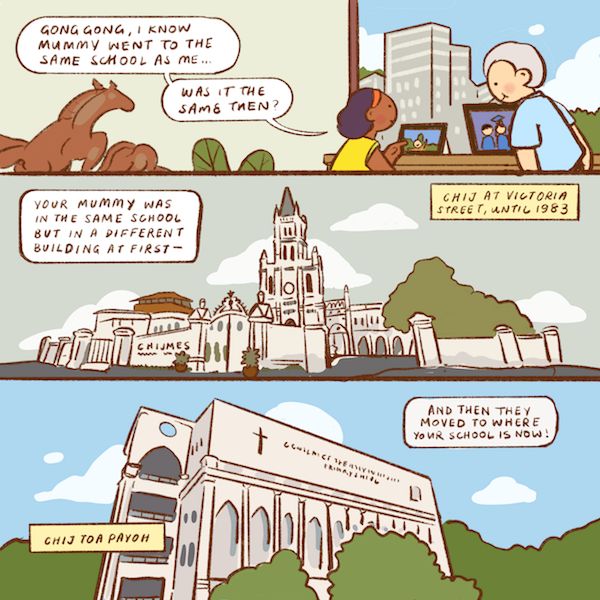
Founded in 1854, the Convent of the Holy Infant Jesus (CHIJ) is the oldest Catholic girls’ school in Singapore. The compound comprised primary and secondary schools, the Chinese-medium St Nicholas Girls’ School (which moved into the premises in 1949), an orphanage, nuns’ quarters, and a chapel.
The red-roofed building in the illustration is Caldwell House. Built in 1840 / 1841, it is the oldest building in the compound (and among the oldest surviving buildings in Singapore), and where the school began. On the second floor, in a circular room, was where the sisters (the IJ Sisters – not biological ones! – who taught the girls) used to work. They did needlework and marked homework, among other things.

This school chapel, the tallest building in the compound, was completed in 1903 – an earlier one had become too small for the ever-expanding school. The spire is five storeys high and stained-glass windows depict the life events of Jesus, and profiles of the twelve apostles. Beyond bringing colour and beauty into the chapel, stained glass was also used to teach those who could not read, to help them understand Bible stories and religious teachings through images.
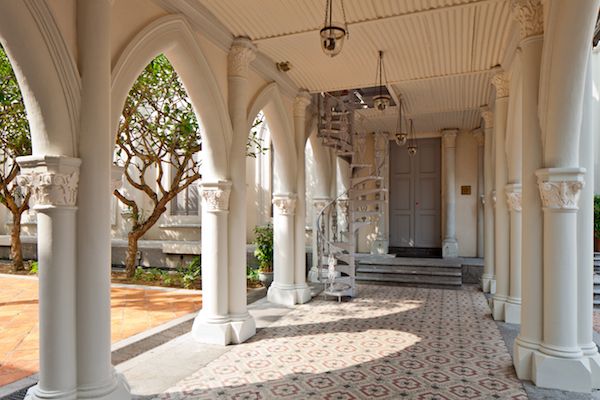
The former CHIJ Chapel and Caldwell House were collectively gazetted as a National Monument in 1990, and today they are part of CHIJMES (pronounced “chimes”), an entertainment complex. Today, CHIJMES is open to the public – if you do go there, see if you can spot a lizard lurking on one of the columns between the chapel and Caldwell House. Say hello, it may be feeling lonely!

The Convent moved out to Toa Payoh in 1983, and CHIJ St Nicholas Girls’ School moved to Ang Mo Kio. There are now eleven CHIJ schools across Singapore.
Curious to know more about a particular school’s history? Look it up at the School Histories Online Repository initiated by the Ministry of Education to capture stories and shared memories of our schools. This repository is an ongoing project and will be updated with information on more schools over time.
Old School Daze
As Nadine looks through old photographs, she realises that apart from class photographs, where mum and her classmates look shy and somewhat stiff, there aren’t many other photographs showing her mum at school.
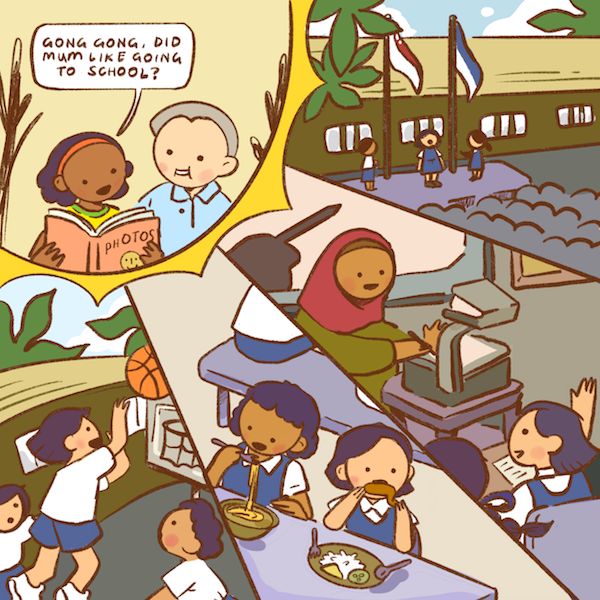
Gong Gong closes his eyes and tries to recall his daughter’s school days. He remembers fragments from when he used to pick her up from school each day – her favourite food at the canteen was the braised chicken wing, how she loved to sing Majulah Singapura even when her classmates kept quiet and how her classmates used to make shadow figures on the overhead projector.
Gong Gong realises that Nadine wouldn’t know what overhead projectors are, and he explains that teachers used to write on transparent plastic sheets, which would then be projected onto a screen in the classroom. “Ooh, sometimes my teachers write on their PowerPoint slides! Is that the same thing?” “I suppose that’s similar,” Gong Gong nods obligingly.
Watch: Semoga Bahagia
A musical thread connecting generations of Singapore is Semoga Bahagia (“May You Achieve Happiness”), which is taught in primary schools and sung on Children’s Day.
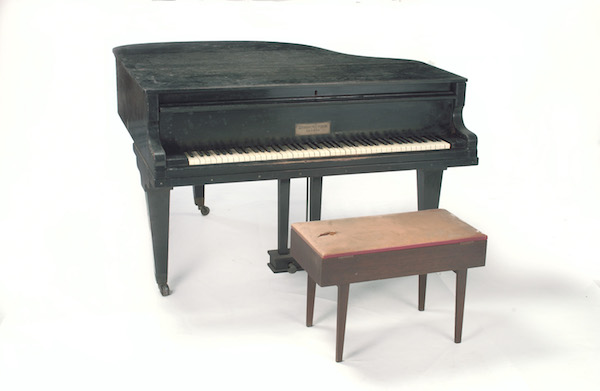
This Strohmenger grand piano belonged to the late Zubir Said. He learnt how to play the piano in his 20s, and used it to compose Singapore’s National Anthem in the late 1950s.
.ashx?h=430&w=645)
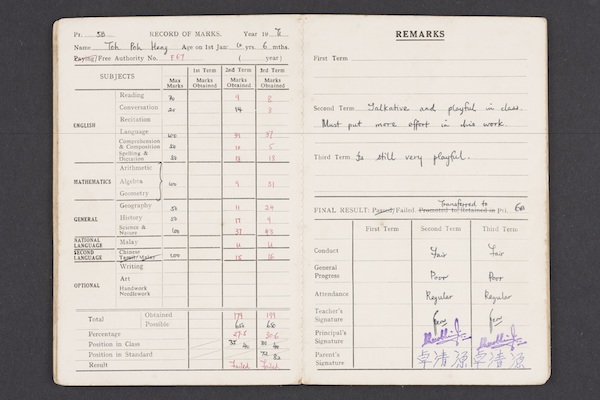
This report book from Havelock School provides some insight into the different subjects that students in Singapore studied in the 1960s – including Malay, the national language, and a second language (what is known as mother tongue language today).
Ask Someone! What were your most treasured items in your childhood or school days, and why? Perhaps a pencil case sewn by a loved one, an extensive collection of country flag erasers (or Pokémon cards, Mighty Beanz), or your autograph book?
Click the arrows to explore some of the items commonly found in school in the past.
The Days Flashing By
At Nadine’s enthusiastic encouragement, Gong Gong brings out more photos of Nadine’s mum and family. Through the pictures, Nadine catches a glimpse of 1980s Singapore, featuring East Coast Park and Van Kleef Aquarium (Singapore’s first public aquarium, named after a Dutchman who resided in Singapore in the late 19th and early 20th centuries)…
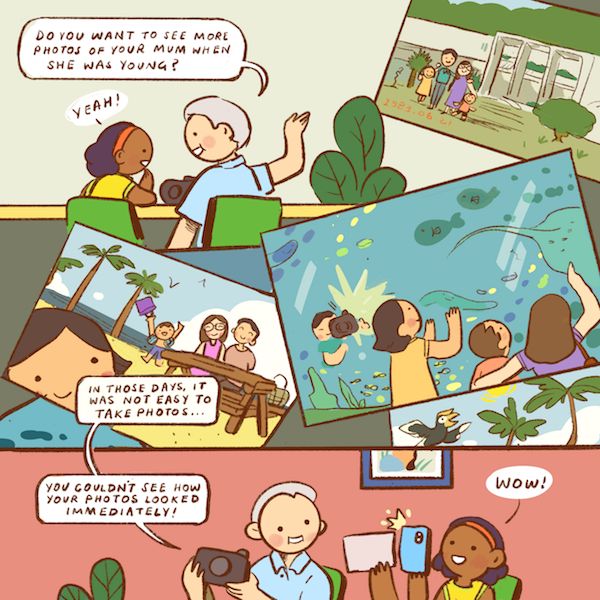
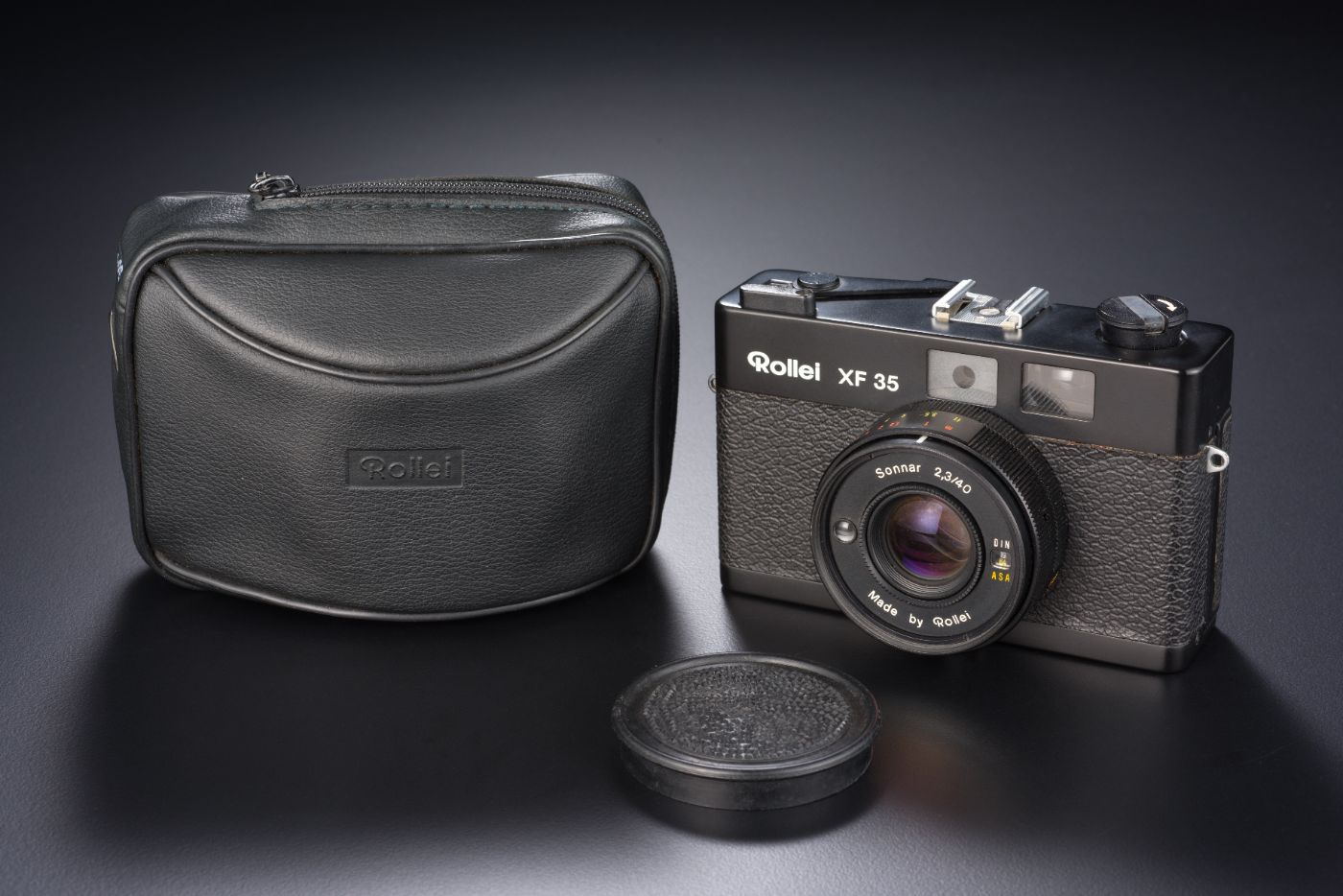
When it was first released in 1974, the Rollei XF35 rangefinder camera was one of the world’s smallest full-frame 35mm cameras. (Now we take photos on much smaller devices, but it was small for its time).
The words on the top of this camera read “MADE IN SINGAPORE”. Rollei, a German manufacturer, set up its first production factory in Singapore at Alexandra Road, in 1971. Rollei moved out of Singapore in 1981 after their parent company went bankrupt.
Ready Player One
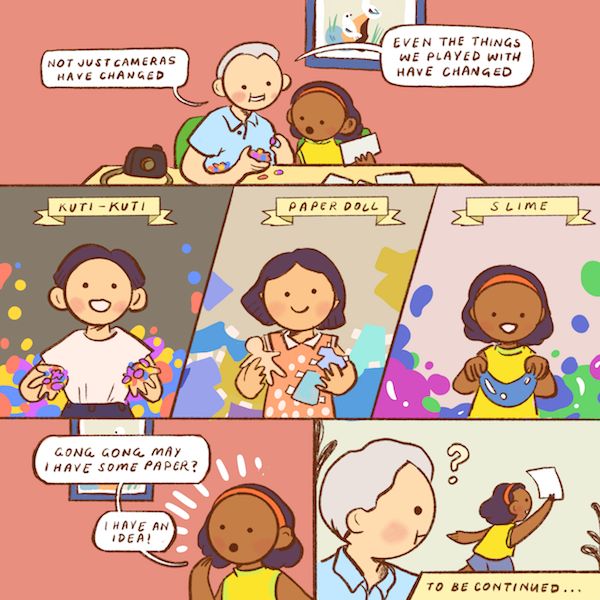
What does Nadine have up her (metaphorical) sleeve? Find out in the next chapter... Link below!
What games do you like to play? Click on Chatbird, the friendly bird at the corner of your screen, for a game of scissors, paper, stone, with a twist!
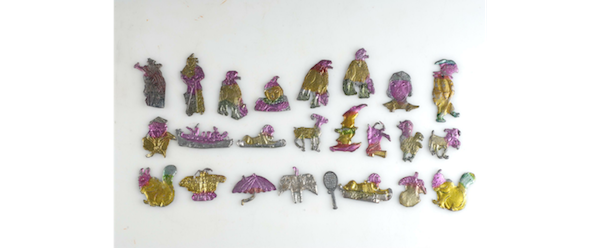
This is a set of kuti-kuti, a favourite game among children from the late 1940s to the 1980s. Players would attempt to flip their kuti-kuti on top of their opponents’ to win the game and their piece. Kuti-kuti sets usually consist of colourful translucent plastic shaped like animals or fruits. This set is uniquely made of metal and includes objects like an umbrella and even features some human figures.
Each player takes out [a kuti-kuti…] and then you use your finger to push it forward and try to get [it] on top of your opponent’s. So, certain figures are better because let’s say it’s a giraffe or elephant, it’s got a slightly thicker body, and its neck or snout is sticking out. It’s got a better chance to get over the opponent’s [piece]. Margaret Thomas, in an oral history recording by the National Archives of Singapore
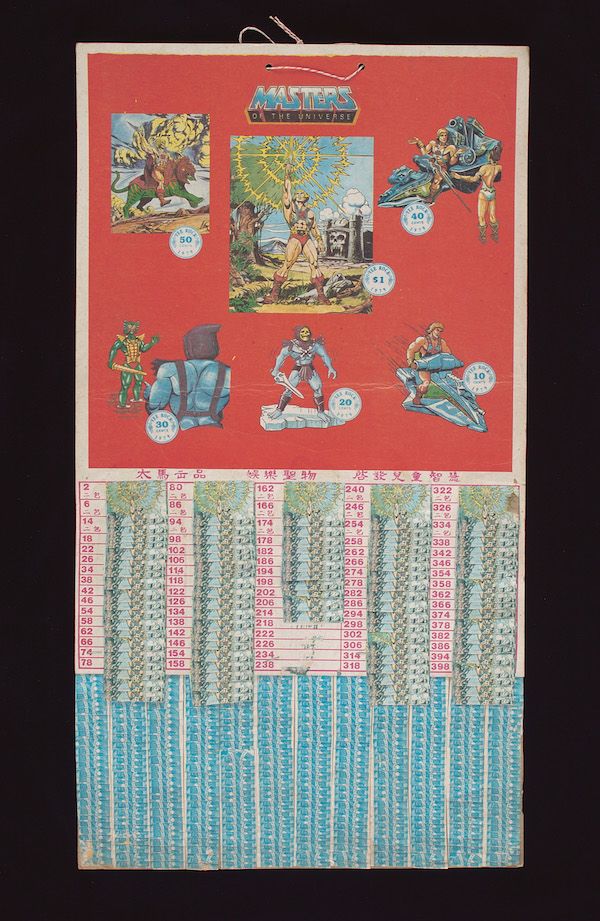
Tikam-tikam (“random pick”) is a lucky draw game that was often found at drink stalls. To play, you’d pay a small sum of money (5 to 20 cents) to pull off your selected tab, and then see if you happened to get a winning one. Prizes (which were decided on by the stall owner) often included soft drinks, a packet of biscuits, a plastic toy, or… more money (in the range of tens of cents)!
Farrer Park
by Ann Peters
I have grown up and gone away
Left my childhood behind
At least this is what I always say
Until something brings it to mind.
A word, a memory will raise it up
From where it had quietly lain
Raking the earth and ancient dust
And I’m back in my childhood again.
"Farrer Park" from Farrer Park: Rhyming Verses from a Singapore Childhood
By Ann Peters
Copyright © 2012
Published by Epigram Books
All rights reserved.
Click here to read Chapter Four, or here to explore other chapters.
This was Chapter Three of the @ Home, Truly digital experience. We hope you enjoyed it! Visit us at Home, Truly: Growing Up with Singapore, 1950s to the Present at Exhibition Gallery 2, National Museum of Singapore (19 Dec 2020 – 29 Aug 2021) to see some of these artefacts in real life, and more!
@ Home, Truly is both a prelude and companion to the physical exhibition, and it covers similar themes, in a different format and through different perspectives and content. Click here to find out more about Home, Truly.




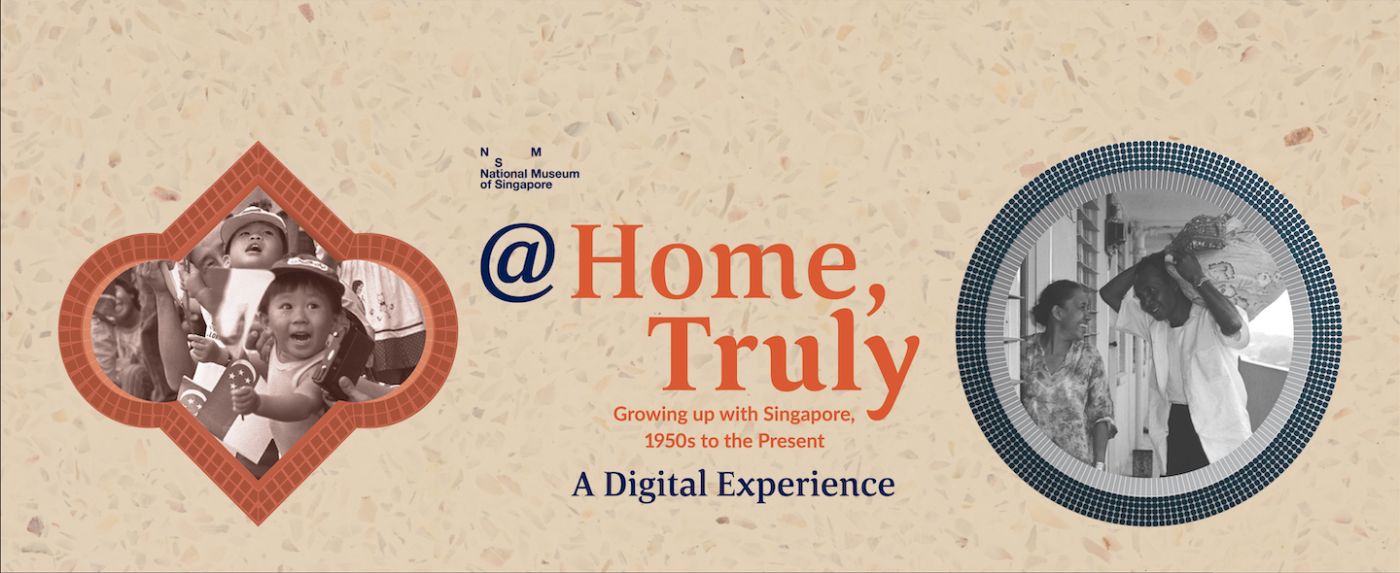
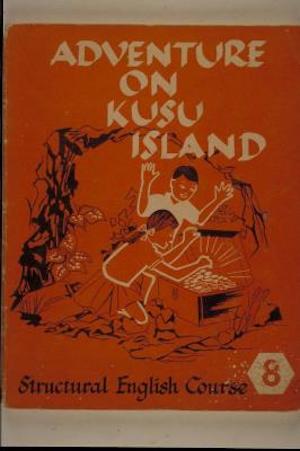
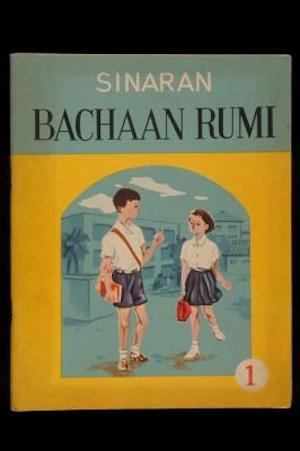

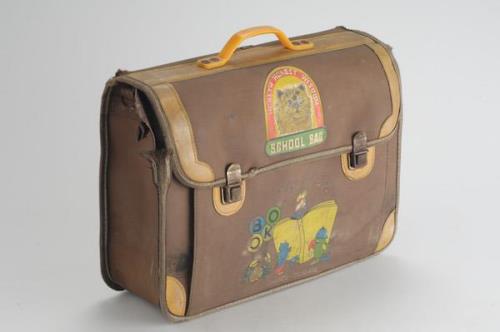
.ashx)
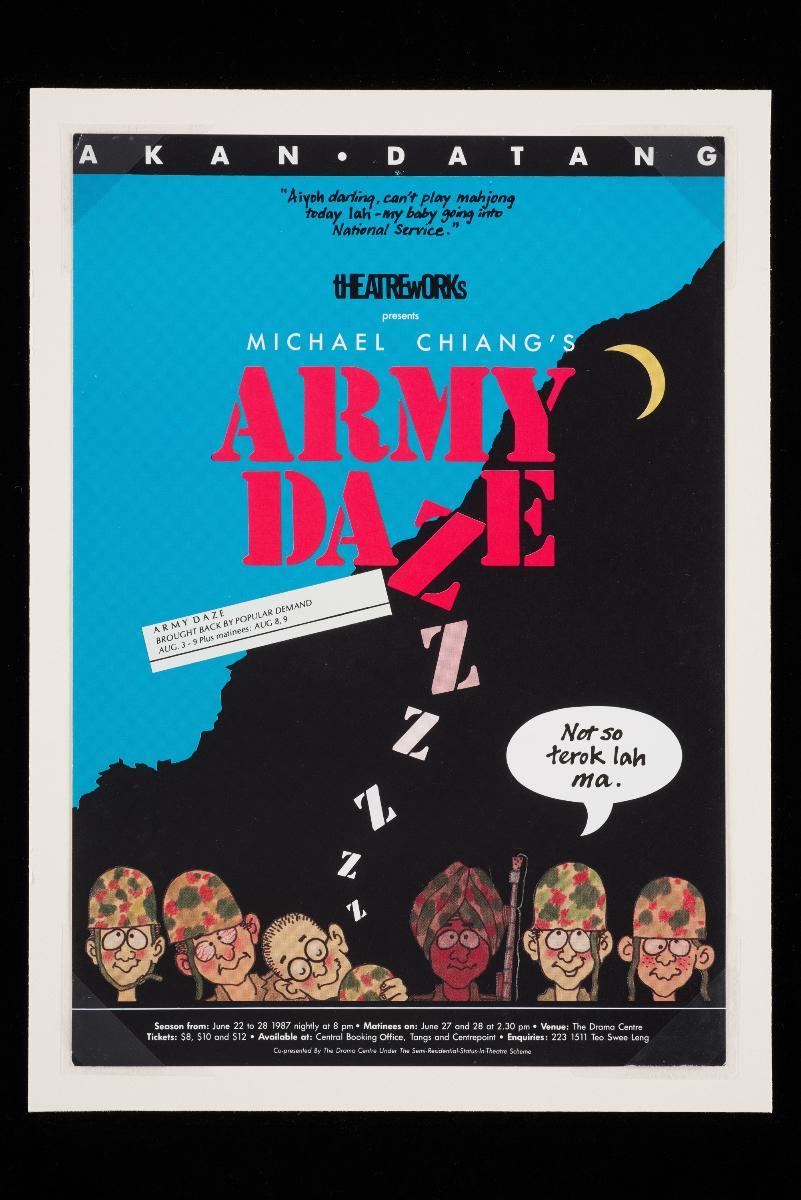

.ashx)
